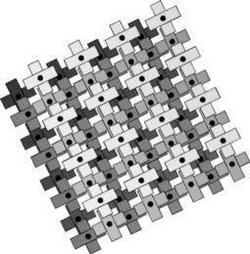Big Waves From a Small Device
Just as advances in semiconductors led to a revolution in electronics, the decade-old field of photonic crystals promises to create a revolution in opto-electronic devices. Photonic crystals, or “photonic band gap” materials, are engineered with periodic changes in the dielectric constant, analogous to the crystal structure of a semiconductor, to create a band gap for photons–a range of frequencies where electromagnetic waves cannot exist in the material. Researchers hope to fabricate crystals with lattice spacings small enough for use at infrared and optical wavelengths, where the most applications are expected, but so far they have succeeded only with two-dimensional crystals. In the microwave band, three-dimensional, tabletop-sized photonic crystals have mainly been used to test the basic principles on models that are easy to build. But in the 30 March PRL, a team shows that photonic crystal devices may be useful even at radio wavelengths, including the important wireless communications band, while maintaining a small device size.
Because photonic crystals allow precise control of the frequencies and directions of propagating electromagnetic waves, researchers foresee numerous applications in such areas as telecommunications and lasers, using mainly infrared and optical frequencies. But Eli Yablonovitch and Dan Sievenpiper at the University of California Los Angeles have begun building photonic band gap structures for longer wavelength applications. They realized that the lower bound of the photonic band gap for a structure of wire mesh or isolated metal islands is closely related to its inductance L and capacitance C and is given roughly by . The team reasoned that if they could make a high-capacitance structure with a small lattice spacing, they could create a wide band gap that extended to much lower frequencies than previous crystals, without increasing the size.
In the PRL paper, the team describes a fairly simple photonic crystal made of 13 stacked printed circuit boards. It has the tetrahedral structure of diamond, where each “atom” is composed of two strips of metal, on opposite surfaces of a board, oriented in perpendicular directions, and connected by a metal-plated hole through the board. Each strip has a high-capacitance coupling with strips on neighboring boards, from which it is separated by only 25 micrometers of insulating material. By transmitting microwaves through the structure in all directions, the group showed that it has a very low frequency band edge and a wide band gap, spanning roughly 15 to 30 GHz. Although the lattice spacing is about four millimeters, the lower band edge wavelength is about two centimeters. The UCLA group collaborated with John Joannopoulos and his colleagues at the Massachusetts Institute of Technology in Cambridge, who calculated the complete band structure of the crystal with computer simulations and found good agreement with the experiments.
Yablonovitch says his work suggests that the lattice spacing does not necessarily determine the available operating wavelengths for a photonic crystal, so that small devices could operate at radio frequencies in cellular phones, for example, to improve their transmission. Although his crystal is essentially a three-dimensional circuit of capacitors and inductors, Yablonovitch is surprised that such structures seem to be new, as he is unaware of any similar studies preceding the work of the past few years.



